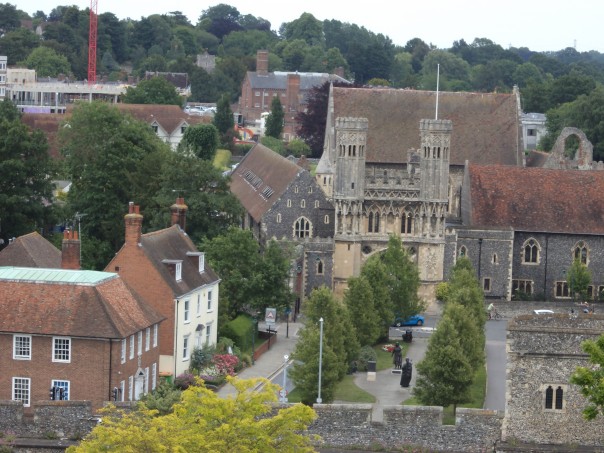As well as various meetings, Professor Louise Wilkinson was heavily involved this Friday and Saturday with the ‘Rebellion in Medieval Europe’ conference which has drawn an international band of scholars together.
More on this below, but I thought I would mention first that Dr Diane Heath has had several meetings this week concerning her various ‘Medieval Animals’ projects, as well as a preparatory meeting at The Royal Harbour Academy, Ramsgate, regarding workshops on family and Magna Carta that will take place next week and in mid July. The July workshops at the school will include engaging with a Tudor play where the central character is King John, and not as you might expect him from popular ideas about ‘bad King John’.
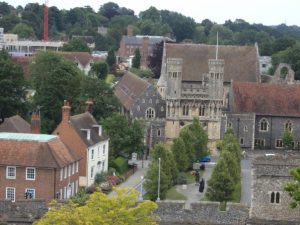
Looking across Canterbury’s UNESCO World Heritage site
At a perhaps even earlier stage of development, I attended a meeting and a workshop this week that hopefully, too, will blossom into great initiatives. The first of these involved a group from St Stephen’s at Hackington just outside Canterbury and concerns Sir Roger Manwood, an extremely interesting Elizabethan judge who was a bit like Marmite, called “A reverend judge of great and excellent knowledge of the law” by Sir Edward Coke, while the lieutenant of Dover Castle wrote “five hundred in Kent would rejoice at his death” (Crown copyright and The History of Parliament Trust 1964-2019). However, the point of this initiative is to remember and celebrate Manwood’s philanthropic activities as the founder of a school at Sandwich, his natal home, and an almshouse at Hakington where he built his mansion house. He was involved in other building projects, too, but I’ll leave them aside for the time being. Although this is still at an early stage, the idea is to hold a series of events – a talk, some drama excerpts and music, at St Stephen’s church and nearby, possibly including at ‘Ye Olde Beverlie’ on Saturday 9 May 2020. I’ll let you know how things develop.
The second initiative, a ‘Green Heritage’ workshop, took place at CCCU as part of the Geography Research Group within the Sustainability Research Network and was led by Professor Peter Vujakovic. As an aside, if you want to meet up with Peter and find out about his sustainability projects around the campus, do come along to St Paul’s church as part of the ‘Medieval Pageant’ on Saturday 6 July because he will be there along with the Centre’s and Canterbury Archaeological Trust’s (CAT) family-friendly activities for ‘young medievalists’.
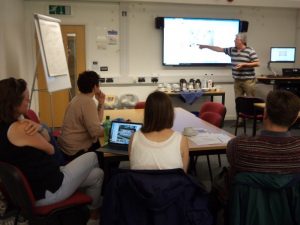
Peter opens the discussion on green heritage
To get back to the workshop, having begun with introductions around the table, which highlighted that there was a good spread of people and interests – historians, geographers and plant scientists from both local universities and Aberystwyth, as well as those actively engaged locally as members of local residents and other associations and societies, such as those involved in the sympathetic management of the Hambrook Marshes, Peter set out what he saw as the rationale for the meeting – what is ‘Green Heritage’? For, as he said, the term does get used although not as often as he had expected in academic journals and other literature, which suggests there may be a major opportunity to decide what we think it is as a way of making it a more valuable and usable term.
To kickstart the discussion, there were 3 short presentations beginning with Professor Howard Thomas (Aberystwyth University) who highlighted the importance of ‘green’, ie chlorophyll and thus plants, which so often these days in a predominantly urban society are ‘invisible’. Take grass, for example, firstly there are between 150 and 160 species that are indigenous or naturalised in the British Isles, and even though this is only a small number compared to worldwide at 10,000 species, yet for most people today grass is grass if they even notice it. Howard is right, and as an ex-dairy farmer I went back to C.E. Hubbard’s Grasses for memories of having to collect specimens as an agricultural student and the pleasure of recognising the different bent and fescue grasses, the beauty of the meadow grasses and even more of quaking grass. Furthermore, it was from ‘grass’ that our cereals came, and Howard drew attention to that now rare ‘weed’ grass of arable land: darnel or to give it its Latin name Lolium termulentum. It is the latter that he sees as culturally important, through the linking of darnel – mentioned in the 1st but not 2nd version of Wycliffe’s Bible translation, and Lollardy. Perhaps, but more broadly it is a fruitful reminder of the centrality of plants and the fundamental role they have, that we ignore them at our peril and that physically and mentally humans are genetically wired into the complexities and benefits of green.
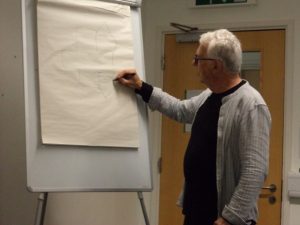
Howard drawing the chlorophyll molecule – could become the ‘green heritage’ logo?
This was a great start and Dr Karen Jones (University of Kent) built on Howard’s ideas by exploring ideas about mapping green heritage in the context of Canterbury, especially where, how, when and why there had been gardens over the centuries. To illustrate these ideas, she focused on Prior Wibert’s ‘Waterworks Plan’ from the 1150s and just what it can show us about green (garden) spaces within the monastic precincts then, but equally now and for the future. This latter point she considers is vital due to the pressures on land for housing and other uses that lead to the loss of such spaces, the nation’s and the community’s green heritage. As she said, she has becoming increasingly interested and active locally regarding how such issues can be addressed in the last few years, in some ways a logical development from her academic work on the ecological history of the wolf in North America. Consequently, even though the scale and type of habitat are very different, the issues and problems are not dissimilar, which lends urgency to what we mean by ‘green heritage’ and how the term can be deployed most fruitfully.
Drawing on both presentations and a discussion I had recently with a couple of local architects who were doing a scoping study on the historical uses of a town square as a way to reflect these for the future, I explored churchyards as green heritage spaces. Consequently, I listed how these places under the guardianship of the parish, where the living and dead come together, were used in the Middle Ages. I’ll just mention two: liturgical rituals such as the Palm Sunday procession, and the holding of civic elections, as at Folkestone and Rye; and what I sought to bring out from all of these was that they offered and offer a sense of space that has time-depth, involve social memory and ideas about cohesion, but also have the potential to fracture the community, for places, like material culture, “were [are] good to remember with”.
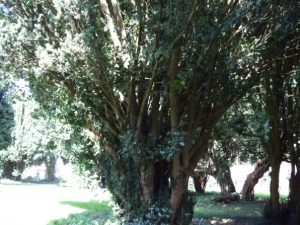
Green Heritage in the churchyard
Peter then opened up the workshop to discussion. Among the many interesting comments and ideas put forward around the table was that UNESCO in its charter does not employ the concept of green heritage but instead works on a binary of cultural heritage and natural heritage. Yet, when you are thinking of most landscapes these days, there is very, very little that comes under the latter because man’s intervention from prehistoric times until the present day is almost everywhere, which suggests some form of intermediate concept is needed.
Another observation was the fallacy of trying to go back in time, and of trying to re-create past landscapes in some sort of time capsule. Peter agreed, saying that on the CCCU campus the idea was to show students the type of trees and other plant species that are likely to have been cultivated there in the past and what they were used for, hence the growing of hops and the brewing of beer for today’s consumers. Another initiative that had come from this was the Heritage A – Z: https://medium.com/the-christ-church-heritage-a-to-z Such ideas people thought fitted well with the concept of green heritage and community engagement, and the curriculum, with health and wellbeing, and biodiversity. However, that still left the group without a definition of ‘green heritage’, and at the end of the workshop it was agreed that Peter would draw up some notes for circulation, and that perhaps a couple of people would put a rough idea together that the group could brain storm at the next meeting as a way to move towards something inclusive that would have a broad appeal among interested organisations, groups and individuals.
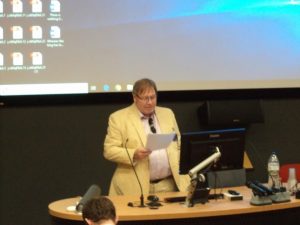
Adrian explores Richard of Cornwall’s actions after Evesham
Moving on to the ‘Medieval Rebellion’ conference, because I cannot do justice to all the speakers, I’m just going to offer a couple of points from each of the CCCU speakers, but this is not reflection on the other very interesting papers I heard on Friday and Saturday. To begin, I had not heard Dr Adrian Jobson (Research Fellow, CCCU) before, thus it was interesting to hear his ideas about how, to what degree and why Richard of Cornwall engaged in the reconciliation process after the royal success at Evesham. I was struck by the way Adrian demonstrated Richard’s willingness to offer some among the de Montfort affinity a way back through service to him, which provided them with social and political redemption, in what might be seen as a measure of his good lordship.
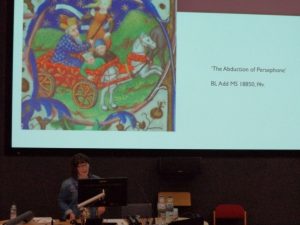
Harriet considers the role of aristocratic women in rebellion
Although exploring the degree of female agency exercised by aristocratic women in their opposition to royal authority, the concept of good governance was also taken up by Dr Harriet Kersey. For example, Isabella de Forz, countess of Devon and Aumale and Lady of the Isle of Wight was widowed at the age of 23 and needed to protect and ultimately enhance the prospects of her six young children. This required skills in estate management and in the conduct of legal proceedings concerning her vast landholdings, but at times of political instability equally necessitated an ability to navigate her way through the pressures placed on her and her family by the warring sides. Harriet demonstrated how Isabella had managed to undertake such a strategy, and that it was only on her deathbed (in 1293) that she finally granted the Isle of Wight to Edward I. For it was only at that point, after almost 30 years of struggle, that she was finally prepared to part with this lordship, because, as Harriet said, “she had no real desire to preserve her extensive inheritance for her very distant heir and cousin, Hugh de Couteney”.
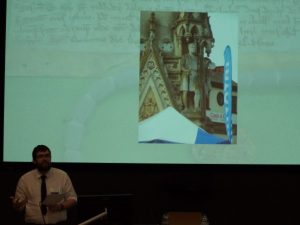
Dean assesses Simon de Montfort’s attitude to money lenders
Dean Irwin, as regular readers of the blog would expect, focused on the Jews and rebellion. Primarily, Dean drew on their experiences in Canterbury and London during the troubled times of the 1260s, and for those interested in what happened at Canterbury, please see: https://blogs.canterbury.ac.uk/kenthistory/yews-jews-aliens-and-canterbury-world-heritage-site-a-busy-week/ In some ways what happened in London bears many similarities in that the attack on the Jewry was aimed at the archae – documents would continue to be a rebel target in succeeding centuries, witness the Peasants’ Revolt attack on the sheriff’s archive at Canterbury Castle in 1381. In April 1264, as part of the attack on the London Jewry and other foreign moneylenders, the archae was taken to the Tower of London. Yet, as at Canterbury, the chest was not destroyed and even though certain debts to individual Jews were cancelled, Dean thinks there was even greater continuity of the system in London than at Canterbury (just over 6-month hiatus). Moreover, Dean believes the evidence of Montfortian and royal involvement in cancelling Jewish and other debts points less to anti-Semitism per se and far more to a hatred of all money-lenders – medieval bankers continuing as targets well after the Jewish expulsion from England under Edward I.
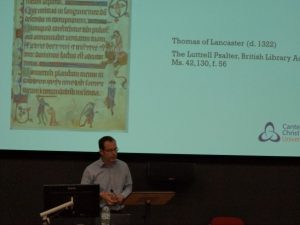
David explores changing attitudes to the role of the commons
The second keynote lecture was given by Dr David Grummitt (Head of Humanities, CCCU), who explored the changing perception and role of the commons in England from the High Middle Ages to the early Tudors. By looking at how far and when they engaged in the political process through the direct action of revolt, he traced not only matters such as the weakness of specific kings, but also how monastic writers and others had viewed the commons, the roots of such discussions dating back to classical Romans, including Cicero. Such writings had expanded in the 14th and even more in the 15th century, drawing on and developing earlier ideas of the commonweal and the body politic, and this “literature of clamour” (Wendy Scase) meant that there was a growing expectation that the commons had a part to play through holding the king to account for good kingship, notwithstanding that to rise against the king was treason. For Henry VIII, as David explained, such ideas were not part of his notion of kingship and the relationship between monarch and people in the sense of the engagement of the latter returned to a position much more in keeping with what the barons at Runnymede would have understood, seeing themselves as the king’s only true counsellors.
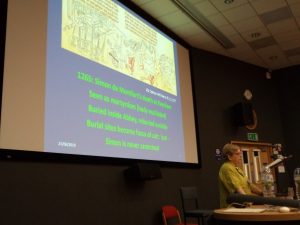
Janet discusses peasants and Simon de Montfort’s rebellion
David’s fascinating survey had certain resonances for the final CCCU speaker, where Janet Clayton explored the evidence for rebellion among the 13th-century peasantry of St Mary Cray in north-west Kent. Janet’s research into the case of the miracle of John son of Philip, whose parents had called on Holy Simon [de Montfort] to save him from drowning, is fascinating and provides valuable hints regarding support for de Montfort from within the peasantry. This case featured in the blog earlier in the year: https://blogs.canterbury.ac.uk/kenthistory/princeton-and-canterbury-bringing-historians-together/
Janet’s paper was in the final session, and, as Adrian said when he made his closing remarks, it had been an exciting couple of days because we had heard about rebellion across much of medieval Europe, which had brought home the many similarities, but also the differences. Moreover, the opportunity to hear about a wide range of case studies and to discuss informally afterwards had been very valuable, and he hoped the networks initiated through the conference would continue, a feeling echoed by all the participants.
 Centre for Kent History and Heritage
Centre for Kent History and Heritage Sheila Sweetinburgh
Sheila Sweetinburgh 1403
1403